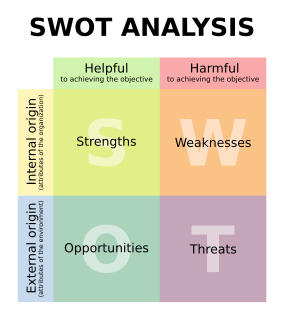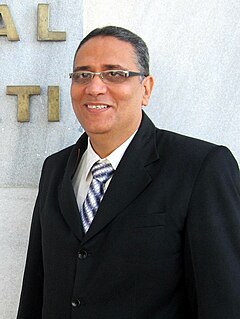
Risk management is the identification, evaluation, and prioritization of risks followed by coordinated and economical application of resources to minimize, monitor, and control the probability or impact of unfortunate events or to maximize the realization of opportunities.
Evaluation is a systematic determination of a subject's merit, worth and significance, using criteria governed by a set of standards. It can assist an organization, program, design, project or any other intervention or initiative to assess any aim, realisable concept/proposal, or any alternative, to help in decision-making; or to ascertain the degree of achievement or value in regard to the aim and objectives and results of any such action that has been completed. The primary purpose of evaluation, in addition to gaining insight into prior or existing initiatives, is to enable reflection and assist in the identification of future change. Evaluation is often used to characterize and appraise subjects of interest in a wide range of human enterprises, including the arts, criminal justice, foundations, non-profit organizations, government, health care, and other human services. It is long term and done at the end of a period of time.
Benchmarking is the practice of comparing business processes and performance metrics to industry bests and best practices from other companies. Dimensions typically measured are quality, time and cost.
Market research is an organized effort to gather information about target markets and customers: know about them, starting with who they are. It is an important component of business strategy and a major factor in maintaining competitiveness. Market research helps to identify and analyze the needs of the market, the market size and the competition. Its techniques encompass both qualitative techniques such as focus groups, in-depth interviews, and ethnography, as well as quantitative techniques such as customer surveys, and analysis of secondary data.

SWOT analysis is a strategic planning and strategic management technique used to help a person or organization identify Strengths, Weaknesses, Opportunities, and Threats related to business competition or project planning. It is sometimes called situational assessment or situational analysis. Additional acronyms using the same components include TOWS and WOTS-UP.
Failure mode and effects analysis is the process of reviewing as many components, assemblies, and subsystems as possible to identify potential failure modes in a system and their causes and effects. For each component, the failure modes and their resulting effects on the rest of the system are recorded in a specific FMEA worksheet. There are numerous variations of such worksheets. An FMEA can be a qualitative analysis, but may be put on a quantitative basis when mathematical failure rate models are combined with a statistical failure mode ratio database. It was one of the first highly structured, systematic techniques for failure analysis. It was developed by reliability engineers in the late 1950s to study problems that might arise from malfunctions of military systems. An FMEA is often the first step of a system reliability study.
In strategic management, situation analysis refers to a collection of methods that managers use to analyze an organization's internal and external environment to understand the organization's capabilities, customers, and business environment. The situation analysis can include several methods of analysis such as the 5C analysis, SWOT analysis and Porter's five forces analysis.
In business analysis, PEST analysis describes a framework of macro-environmental factors used in the environmental scanning component of strategic management. It is part of an external analysis when conducting a strategic analysis or doing market research, and gives an overview of the different macro-environmental factors to be taken into consideration. It is a strategic tool for understanding market growth or decline, business position, potential and direction for operations.
A feasibility study is an assessment of the practicality of a project or system. A feasibility study aims to objectively and rationally uncover the strengths and weaknesses of an existing business or proposed venture, opportunities and threats present in the natural environment, the resources required to carry through, and ultimately the prospects for success. In its simplest terms, the two criteria to judge feasibility are cost required and value to be attained.
Software project management is an art and science of planning and leading software projects. It is a sub-discipline of project management in which software projects are planned, implemented, monitored and controlled.
Context analysis is a method to analyze the environment in which a business operates. Environmental scanning mainly focuses on the macro environment of a business. But context analysis considers the entire environment of a business, its internal and external environment. This is an important aspect of business planning. One kind of context analysis, called SWOT analysis, allows the business to gain an insight into their strengths and weaknesses and also the opportunities and threats posed by the market within which they operate. The main goal of a context analysis, SWOT or otherwise, is to analyze the environment in order to develop a strategic plan of action for the business.
A market analysis studies the attractiveness and the dynamics of a special market within a special industry. It is part of the industry analysis and thus in turn of the global environmental analysis. Through all of these analyses, the strengths, weaknesses, opportunities and threats (SWOT) of a company can be identified. Finally, with the help of a SWOT analysis, adequate business strategies of a company will be defined. The market analysis is also known as a documented investigation of a market that is used to inform a firm's planning activities, particularly around decisions of inventory, purchase, work force expansion/contraction, facility expansion, purchases of capital equipment, promotional activities, and many other aspects of a company.
A needs assessment is a systematic process for determining and addressing needs, or "gaps" between current conditions and desired conditions or "wants". The discrepancy between the current condition and wanted condition must be measured to appropriately identify the need. The need can be a desire to improve current performance or to correct a deficiency.
A test method is a method for a test in science or engineering, such as a physical test, chemical test, or statistical test. It is a definitive procedure that produces a test result. In order to ensure accurate and relevant test results, a test method should be "explicit, unambiguous, and experimentally feasible.", as well as effective and reproducible.
BSC SWOT, or the Balanced Scorecard SWOT analysis, was first introduced, in 2001, by Lennart Norberg and Terry Brown.

The Surface Water and Ocean Topography (SWOT) mission is a future satellite altimeter jointly developed by NASA and CNES, the French space agency, in partnership with the Canadian Space Agency (CSA) and UK Space Agency (UKSA). The objectives of the mission are to make the first global survey of the Earth's surface water, to observe the fine details of the ocean surface topography, and to measure how terrestrial surface water bodies change over time. While past satellite missions like the Jason series altimeters have provided variation in river and lake water surface elevations at select locations, SWOT will provide the first truly global observations of changing water levels, slopes, and inundation extents in rivers, lakes, and floodplains. In the world's oceans, SWOT will observe ocean circulation at unprecedented scales of 15–25 km (9.3–15.5 mi), approximately an order of magnitude finer than current satellites. Because it uses wide-swath altimetry technology, SWOT will almost completely observe the world's oceans and freshwater bodies with repeated high-resolution elevation measurements, allowing observations of variations.
Small-scale project management is the specific type of project management of small-scale projects. These projects are characterised by factors such as short duration; low person hours; small team; size of the budget and the balance between the time committed to delivering the project itself and the time committed to managing the project. They are otherwise unique, time delineated and require the delivery of a final output in the same way as large-scale projects.
In organizational theory, organizational analysis or industrial analysis is the process of reviewing the development, work environment, personnel, and operation of a business or another type of association. This review is often performed in response to crisis, but may also be carried out as part of a demonstration project, in the process of taking a program to scale, or in the course of regular operations. Conducting a periodic detailed organizational analysis can be a useful way for management to identify problems or inefficiencies that have arisen in the organization but have yet to be addressed, and develop strategies for resolving them.

Javier Perez-Capdevila is a Cuban scientist, mathematician and professor, known for the introduction of the operation mixed mixtures of fuzzy sets, among other theoretical contributions to fuzzy mathematics, as well as to introduce a concept of labor competencies with a method to measure them.



